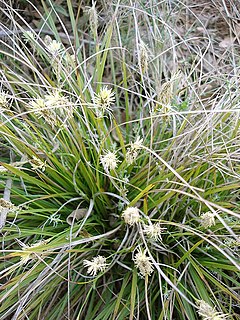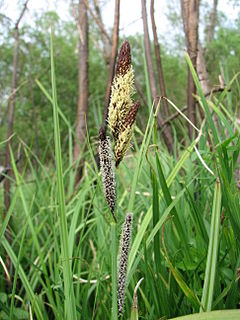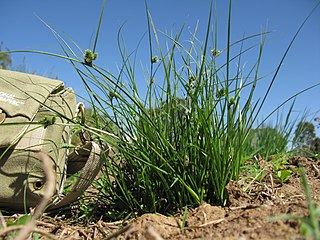
Carex is a vast genus of more than 2,000 species of grass-like plants in the family Cyperaceae, commonly known as sedges. Other members of the family Cyperaceae are also called sedges, however those of genus Carex may be called true sedges, and it is the most species-rich genus in the family. The study of Carex is known as caricology.

Carex flacca, with common names blue sedge, gray carex, glaucous sedge, or carnation-grass,, is a species of sedge native to parts of Europe and North Africa. It is frequent in a range of habitats, including grasslands, moorlands, exposed and disturbed soil, and the upper edges of salt marshes. It has naturalized in eastern North America.

Kingdown and Middledown is a 5.7 hectare biological Site of Special Scientific Interest near Cheddar in the Mendip Hills, Somerset, notified in 1991.

Carex echinata is a species of sedge known by the common names star sedge and little prickly sedge.

Carex limosa is a species of sedge known as bog-sedge, mud sedge, and shore sedge.

Carex comosa is a species of sedge known as longhair sedge and bristly sedge. It is native to North America, where it grows in western and eastern regions of Canada and the United States, and parts of Mexico. It grows in wet places, including meadows and many types of wetlands. Tolerates deeper water than most common species and is good for retention basins. This sedge produces clumps of triangular stems up to 100 or 120 centimeters tall from short rhizomes. The inflorescence is up to 35 centimeters long and has a long bract which is longer than the spikes. It is a cluster of several cylindrical spikes. The scales over the fruits taper into long, thin awns.

Carex scoparia is a species of sedge known by the common names broom sedge and pointed broom sedge. It should not be confused with the unrelated grass species known as "broom sedge," Andropogon virginicus.

Carex disticha is a Eurasian species of sedge known as the brown sedge or, in North America, tworank sedge.

Carex acutiformis, the lesser pond-sedge, is a species of sedge.

Pow Hill Bog is a Site of Special Scientific Interest in the Wear Valley district of County Durham, England. It lies alongside Derwent Reservoir, approximately 2 km north-west of the village of Edmundbyers and adjacent to the Edmundbyers Common portion of the Muggleswick, Stanhope and Edmundbyers Commons and Blanchland Moor SSSI.

Carex inversa, commonly known as knob sedge, is a species of sedge of the family Cyperaceae that is native to parts of Australia and New Zealand and has also been introduced into Great Britain.
Carex tereticaulis, also known as basket sedge, is a species of sedge of the family Cyperaceae that is native to southern parts of Western Australia, southern parts of South Australia, southern and eastern parts of New South Wales as well as north western and central Victoria and Tasmania. The Koori peoples know the plant as Poong'ort.

Carex flava, called hedgehog grass, is a widespread species of sedge, native to the northern United States, Canada, Iceland, Europe, the Atlas Mountains in Africa, the Transcaucasus area, and parts of Siberia. It is the namesake of the Carex flava species complex.
Carex perakensis is a tussock-forming species of perennial sedge in the family Cyperaceae. It is native to parts of the South East Asia and Malesia.

Carex scaposa, also known as hua ting tai cao in Chinese, is a tussock-forming species of perennial sedge in the family Cyperaceae. It is native to eastern parts of Asia.
Carex shanensis is a tussock-forming species of perennial sedge in the family Cyperaceae. It is native to parts of Myanmar.
Carex simulans is a tussock-forming species of perennial sedge in the family Cyperaceae. It is native to southern parts of China.
Carex turrita is a tussock-forming species of perennial sedge in the family Cyperaceae. It is native to parts of the Philippines and Papua New Guinea.
Carex caespititia is a tussock-forming species of perennial sedge in the family Cyperaceae. It is native to parts of Asia from Assam in northern India in the west to central China in the east.
Carex cirrhulosa is a tussock-forming species of perennial sedge in the family Cyperaceae. It is native to parts of the Philippines.












